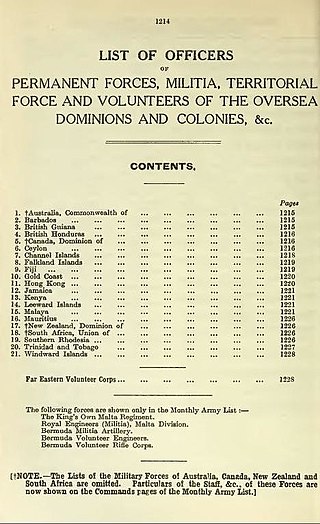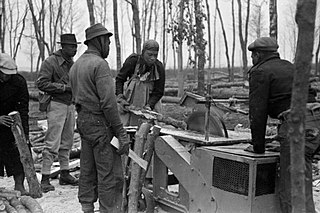
A militia is generally an army or some other fighting organization of non-professional and/or part-time soldiers; citizens of a country, or subjects of a state, who may perform military service during a time of need, as opposed to a professional force of regular, full-time military personnel; or, historically, to members of a warrior-nobility class. When acting independently militias are generally unable to hold ground against regular forces; militias commonly support regular troops by skirmishing, holding fortifications, or conducting irregular warfare, instead of undertaking offensive campaigns by themselves. Local civilian laws often limit militias to serve only in their home region, and to serve only for a limited time; this further reduces their use in long military campaigns. Militias may also, however, serve as a pool of available manpower for regular forces to draw from, particularly in emergencies.

The 3rd United States Infantry Regiment is a regiment of the United States Army. It currently has three active battalions, and is readily identified by its nickname, The Old Guard, as well as Escort to the President. The regimental motto is Noli Me Tangere. The regiment is a major unit of the Military District of Washington (MDW). The 3rd Infantry is the oldest regiment still active in the Regular Army, having been first organized as the First American Regiment in 1784. It has been the official ceremonial unit of the U.S. Army since 1948.

The Royal Hamilton Light Infantry (Wentworth Regiment) (RHLI) is a Primary Reserve infantry regiment of the Canadian Army, based at John Weir Foote VC Armoury in Hamilton, Ontario. The RHLI is part of 31 Canadian Brigade Group, which is part of 4th Canadian Division.

The Royal Newfoundland Regiment is a Primary Reserve infantry regiment of the Canadian Army. It is part of the 5th Canadian Division's 37 Canadian Brigade Group.

The Grey and Simcoe Foresters is a Primary Reserve infantry regiment of the Canadian Forces. Within the Canadian Army, it is part of the 4th Canadian Division's 31 Canadian Brigade Group. Due to the restructuring of the British Army, The Worcestershire and Sherwood Foresters Regiment was amalgamated into The Mercian Regiment, as its 2nd Battalion, leaving The Grey and Simcoe Foresters as the only remaining unit in the Commonwealth of Nations known to be distinctly designated as a regiment of Foresters.

The history of Canada during World War II begins with the German invasion of Poland on 1 September 1939. While the Canadian Armed Forces were eventually active in nearly every theatre of war, most combat was centred in Italy, Northwestern Europe, and the North Atlantic. In all, some 1.1 million Canadians served in the Canadian Army, Royal Canadian Navy, Royal Canadian Air Force, out of a population that as of the 1941 Census had 11,506,655 people, and in forces across the empire, with approximately 42,000 killed and another 55,000 wounded. During the war, Canada was subject to direct attack in the Battle of the St. Lawrence, and in the shelling of a lighthouse at Estevan Point on Vancouver Island, British Columbia.
The 157th Battalion, CEF was a unit in the Canadian Expeditionary Force during the First World War.

The Bermuda Volunteer Rifle Corps (BVRC) was created in 1894 as a reserve for the Regular Army infantry component of the Bermuda Garrison. Renamed the Bermuda Rifles in 1951, it was amalgamated into the Bermuda Regiment in 1965.

The Canadian Forestry Corps was an administrative corps of the Canadian Army with its own cap badge, and other insignia and traditions.
The Fencibles were British regiments raised in the United Kingdom, Isle of Man and in the colonies for defence against the threat of invasion during the Seven Years' War, the American War of Independence, the French Revolutionary Wars, the Napoleonic Wars and the War of 1812 in the late 18th and early 19th centuries. Usually temporary units, composed of local recruits and commanded by Regular Army officers, they were usually confined to garrison and patrol duties, freeing Regular Army units to perform offensive operations. Most fencible regiments had no liability for overseas service.

The 71st New York Infantry Regiment is an organization of the New York State Guard. Formerly, the 71st Infantry was a regiment of the New York State Militia and then the Army National Guard from 1850 to 1993. The regiment was not renumbered during the early 1920s Army reorganization due to being broken up to staff other units from 1917 to 1919, and never received a numerical designation corresponding to that of a National Guard regiment.
The Royal Wiltshire Militia was an auxiliary regiment of the British Army from the English county of Wiltshire. From their formal organisation as Trained Bands in 1558 until their final service in the Special Reserve, the Militia regiments of the county carried out internal security and garrison duties at home and overseas in all of Britain's major wars. The Wiltshire Militia was active in suppressing Monmouth's Rebellion in 1685 and was present at the Battle of Sedgemoor. It became a battalion of the Wiltshire Regiment in 1881 and trained thousands of reservists and recruits during World War I. It maintained a shadowy existence until final disbandment in 1953.

The British Colonial Auxiliary Forces were the various military forces of Britain's colonial empire which were not considered part of the British military proper.

The British Militia was the principal military reserve force of the Kingdom of Great Britain. Militia units were repeatedly raised in Great Britain during the Georgian era for internal security duties and to defend against external invasions. The Militia Act 1757, passed by the Parliament of Great Britain after the outbreak of the Seven Years' War, led to the rapid expansion of the British Militia in order to defend from potential French invasions. In the Kingdom of Ireland, a client state of Great Britain, the equivalent force was the Irish Militia, which saw heavy service in the Irish Rebellion of 1798 alongside British militia units. The existence of militia units in Great Britain and Ireland played an important role in freeing regular troops from the British and Irish establishments for overseas service.
The 222nd Infantry Brigade was a Home Service formation of the British Army that existed under various short-lived titles in both the First and Second World Wars

Elements of the Second Australian Imperial Force (AIF) were located in the United Kingdom (UK) throughout World War II. For most of the war, these comprised only a small number of liaison officers. However, between June and December 1940 around 8,000 Australian soldiers organised into two infantry brigades and supporting units were stationed in the country. Several small engineer units were also sent to the UK, and up to 600 forestry troops were active there between July 1940 and mid-1943. A prisoner of war (POW) repatriation unit arrived in the UK in August 1944, and over 5,600 released AIF prisoners eventually passed through the country. Following the war, small numbers of Australian soldiers formed part of a military cricket team which toured England, and the Army contributed most members of the Australian contingent to the June 1946 victory parade in London.
When the Second World War broke-out, the Dominion of Newfoundland was a Dominion governed directly from the United Kingdom via the Commission of Government. As Newfoundland was being administered by the Commission of Government, and had no functioning parliament, the British declaration of war on Germany automatically brought Newfoundland into a state of war with Germany on 3 September 1939.

The Australian Forestry Group UK was an element of the Second Australian Imperial Force raised for forestry duties. Its constituent units were established in 1940 and 1941 in response to a request from the British Government for foresters to work in France. After the fall of France the three Australian forestry companies were sent to the United Kingdom. The group headquarters was raised in July 1941. The foresters worked in northern England and Scotland, and had a secondary military role. The Australian Forestry Group returned to Australia via the United States in 1943, and its three companies later served in the Northern Territory and New Guinea.

The British Honduran Forestry Unit (BHFU) was a civilian body of forestry workers who came from British Honduras to Scotland in two contingents to help support the war effort during the Second World War. 900 workers came, the first 500 arriving in September 1941 and were dispersed to camps in Traprain Law, East Lothian, Duns, Scottish Borders, and Kirkpatrick Fleming, Dumfries and Galloway. The second contingent of 400 arrived in November 1942, and were allocated to Golspie, Sutherland, and Kinlochewe and Achnashellach both in Wester Ross. In 1943 the Unit was disbanded.
The Veterans Guard of Canada was a citizen militia supporting the Canadian Army during the Second World War, tasked with defending mainland Canada. They were modelled after the British Home Guard.
















